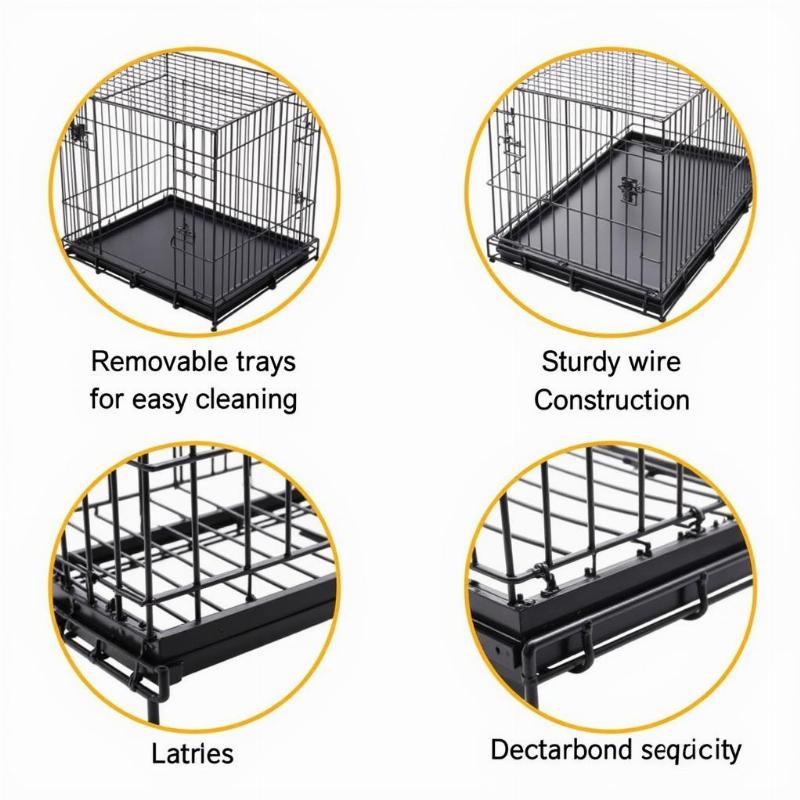Choosing the right size dog cage for your Labrador is crucial for their comfort and well-being. A cage that’s too small can be restrictive and stressful, while one that’s too large can defeat the purpose of creating a den-like space. This guide will help you determine the perfect what size dog cage for labrador, ensuring a happy and secure environment for your furry friend.
Labrador Size and Cage Dimensions
Labradors are a medium-to-large breed, so you’ll need a cage that accommodates their adult size. Even if you have a puppy, it’s best to purchase a cage for their full-grown size to avoid having to buy another one later. A good rule of thumb is to measure your Labrador from nose to tail and from the top of their head to the floor (while standing). Add a few inches to both measurements to ensure they can comfortably stand, turn around, and lie down in the cage. Typically, a 36-inch or 42-inch dog cage is suitable for most adult Labradors.
Different Cage Types for Labradors
Several types of dog cages are available on the market, each with its own pros and cons. Wire cages are popular for their durability, ventilation, and visibility. Plastic cages are lightweight and easy to clean, making them a good choice for travel. Heavy-duty metal cages are ideal for strong chewers or dogs who are prone to escaping. Consider your Labrador’s personality and needs when selecting a cage type. For instance, a particularly anxious Labrador might benefit from the added security of a heavy-duty cage.
Key Factors to Consider When Choosing a Labrador Cage
Besides size, other factors to consider when choosing a what size dog cage for a labrador include durability, ease of cleaning, portability, and security. Look for a cage made from sturdy materials that can withstand your Labrador’s chewing habits. Easy-to-clean features, such as removable trays, are a must for maintaining hygiene. If you plan to travel with your Labrador, a lightweight and portable cage is essential.
 Key factors when choosing a dog cage
Key factors when choosing a dog cage
Cage Placement and Training Tips
Where you place your Labrador’s cage in your home is important. Choose a location that’s not too isolated, but also not too busy. Your Labrador should feel like their cage is a safe haven, not a place of punishment. Introduce the cage gradually and positively, using treats and toys to create positive associations. Never force your Labrador into the cage. With patience and consistent training, your Labrador will learn to love their cage as their own personal space. Crate training can also help with housebreaking, preventing destructive behavior, and providing a secure space for your Labrador when you’re away.
What Size Dog Cage For a Labrador Puppy?
While you should ideally purchase a cage for your Labrador’s adult size, you can use dividers to make the space smaller when they’re a puppy. This prevents them from using one side as a bathroom and the other for sleeping. As they grow, you can gradually adjust the divider to give them more space. Remember, a comfortable and secure environment is essential for your Labrador’s well-being.
Conclusion
Choosing the right what size dog cage for labrador involves considering their size, breed characteristics, and individual needs. By following these guidelines, you can provide your Labrador with a comfortable and secure space that they’ll love.
FAQ
-
How do I measure my Labrador for a cage? Measure from nose to tail and from the top of their head to the floor (while standing), then add a few inches to both measurements.
-
What type of cage is best for a Labrador? Wire, plastic, and heavy-duty metal cages are all options, depending on your Labrador’s personality and needs.
-
Where should I place my Labrador’s cage? Choose a location that’s not too isolated, but also not too busy.
-
How do I introduce my Labrador to their cage? Introduce the cage gradually and positively, using treats and toys.
-
What size cage do I need for a Labrador puppy? Purchase a cage for their adult size and use dividers to make the space smaller when they’re a puppy.
-
Can crate training help with housebreaking? Yes, crate training can assist with housebreaking by preventing accidents and establishing a routine.
-
Is it cruel to crate a Labrador? No, when done correctly, crate training provides a safe and secure den-like space for your Labrador.
Related Articles
- dog cage size for labrador
- what size dog cage for a labrador
- dog crate size for labrador retriever
- bailey and bella dog coats
- dog sweater knitting pattern free
Beautdogs.us is your premier online resource for all things dog-related in the US. We offer expert advice on dog breeds, care, training, and product recommendations. Whether you’re a new dog owner or a seasoned pro, Beautdogs.us provides reliable information and resources to help you provide the best possible care for your furry companion. Contact us today for more information! Email: [email protected], Phone: +1 501-555-7529. Visit Beautdogs.us for all your dog-related needs!